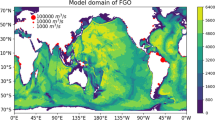Abstract
Based on the measurements from the US National Data Buoy Center 3-m discus buoy site No. 44004 (38.5°N, 70.47°W) from January 1 to March 31 of 2003, with the COARE algorithm (Version 3.0), the results from four parameterization schemes developed recently for sea surface aerodynamic roughness length were compared with each other. Calculations of frictional speedu*, drag coefficientC d and wind stress τ indicate that the calculated frictional velocities from the four schemes (8.50%–16.20%, the normalized standard error estimate, or NSEE), the computed drag coefficients and wind stress (respectively 15.08%–28.67% and 17.26%–50.59% NSEE) are reasonable. Schemes YT96 and GW03 are consistent. The O02 scheme gives over-estimated values foru* andC d. Schemes TY01 and GW03 display discontinuous characteristics in handling young wave data.
Similar content being viewed by others
References
Charnock, H., 1955. Wind stress on water surface.J. Roy Meterol. Soc. 81: 639–640.
Donelan, M., F. W. Dobson, S. D. Smith and R. J. Anderson, 1993. On the dependence of sea surface roughness on wave development.J. Phys. Oceanog. 23: 2143–2149.
Fairall, C. W., E. F. Bradley, D. P. Rogers, J. B. Edson and G. S. Young, 1996. Bulk parameterization of air-sea fluxes for TOGA COARE.J. Geophys. Res. 101: 3747–3764.
Gao, Z. Q. and Q. Wang, 2005. Dependence of sea surface aerodynamic roughness on wave parameters, submitted toQuarterly Journal of Applied Meterology (in press)
Oncley, S. P. and J. Dudhia, 1995. Evaluation of surface fluxes from MM5 using observations.Mon. Wea. Rev. 123: 3344–3357.
Oost, W. A., G. J. Komen, C. M. J. Jacobs and C. van Oort, 2002. New evidence for a relation between wind stress and wave age from measurements during ASGAMAGE.Bound-Layer Meteor. 103: 409–438.
Smith, S. D., 1988. Coefficients for sea surface wind stress, heat flux, and wind profiles as a function of wind speed and temperature.J. Geophys. Res. 93: 15467–15472.
Taylor, P. K. and M. J. Yelland, 2001. The dependence of sea surface roughness on the height and steepness of the waves.J. Phys. Oceanog. 31: 572–590.
Yelland, M. and P. K. Taylor, 1996. Wind stress measurements from the open ocean.J. Phys. Oceanogr. 26: 541–558.
Author information
Authors and Affiliations
Corresponding author
Additional information
This work is supported by Nanjing University of Information Science & Technology, Jiangsu Key Laboratory of Meterological Disaster Program (KLME 050210).
Rights and permissions
About this article
Cite this article
Wenyu, S., Qijun, G., Yuping, P. et al. Comparison among sea surface roughness schemes. Chin. J. Ocean. Limnol. 23, 376–382 (2005). https://doi.org/10.1007/BF02842680
Received:
Accepted:
Issue Date:
DOI: https://doi.org/10.1007/BF02842680




